|
Althaea, Althea, Rose of Sharon
BY D. GREG GRANT:
Hibiscus syriacus ‘Greba (Greenleaf Nurseries Blue Angel)’ ‘Blue Angel’
Hibiscus syriacus ‘Grewa (Greenleaf Nurseries White Angel)’ ‘White Angel’
(althaea, althea, rose of Sharon)
Malvaceae (mallow family)
Zones 5-9 (all of the South)
These beautiful shrubs have been neglected and their advantages for lawn decorations, as single plants or in clumps or hedges, overlooked. They bloom from May till fall, during our hottest, driest weather, when flowers are scarce. They do not require watering, and demand little attention. They are decided acquisitions to any flower garden.
Rosedale Nurseries Catalog, Brenham, Texas, 1899.
Hibiscus syriacus is a native of India and China. In China where it has been cultivated for as long as records exist, both the leaves and flowers were used as food. In 1597 Gerard planted seeds of the "Tree Mallow" and in 1629 Parkinson cultivated it. In 1759 Miller described seven kinds: "the most common hath purple Flowers with dark Bottoms, another hath bright purple Flowers with black Bottoms, a third hath white Flowers with purple Bottoms, a fourth variegated Flowers with dark Bottoms, and a fifth pale yellow flowers with dark Bottoms but the last is very rare at present in the English Gardens; there are also two with variegated leaves which are by some much esteemed." In 1778 Abercrombie called the plant "the greatest ornament of the autumn season, of almost any of the shrubby tribe..." Double flowered forms aren't mentioned until 1838 when Loudon said they were common.
Althaeas have been in southern gardens from the beginning of our gardening heritage. Thomas Jefferson planted althaea seeds at Shadwell in April of 1767 and set out plants at Monticello in March of 1794 and also at Poplar Forest in December of 1812.
Althaeas were carried by almost all early southern nurseries dealing in ornamentals. In a poll of 19 nurseries from 1851-1906 16 of them offered althaea, making it the most popular southern nursery plant, just ahead of arborvitae, honeysuckles and roses. Thomas Affleck's Southern Nurseries, at Washington, Mississippi, listed "Fine new double Althaeas, a dozen sorts" in the 1851-52 catalog. Montgomery Nurseries (Alabama) also listed althaea in their 1860 catalog. Established in Brenham in 1860, one of the earliest in Texas, Rosedale Nurseries stated in a 1901 catalog: "We can supply about twenty named varieties in Single and Double; White, Pink, Red, Purple, and all their modifications and combinations; also the Variegated-leaved, with purple flowers."
Althaeas, in all their forms, are still supremely adapted to our gardens today. The future may even be better however. In the sixties, the late Dr. Donald Egolf, formerly of the National Arboretum in Washington, D.C., and well known for his many crape myrtle hybrids, developed a series of sterile triploids which have larger, earlier flowers, and little to no seed development. They are: 'Diana' (white), 'Helene' (white with maroon throat), 'Minerva' (lavender), and 'Aphrodite' (pink). These new types have grown just as well for me as the old standards. They seem to bloom a bit earlier and have larger flowers. I have had some seed development however.
Althaeas are very easy to cultivate in just about any soil that is well drained and located in part to full sun, preferring the latter. They are, however, susceptible to cotton root rot in areas with alkaline soils. They can be grown as either shrubs or limbed up to small trees. Propagation is by seeds, if you aren't picky about the offspring, or cuttings rooted under high humidity.
Most people have quit using Althaeas today in favor of the more popular crape myrtle. In this new era of plant diversification and old fashioned plants, the time is right for the rose of Sharon to obtain her rightful place as the queen of the southern garden...or at least a princess.
BY DR. SAM MCFADDEN:
Althaeas grow quickly and need little attention. They thrive in the heat of summer and require only occasional deep watering to keep them growing and blooming. Native to China and India, they have been cultivated as long as records exist. The Chinese used the flowers and leaves for food. Thomas Jefferson grew them from seed, and was documented to have planted them at all three of his homes.
Colors range from white to pink, lavender, and reddish purple. Several kinds have dark-colored centers in the flowers, and single-flowering types are quite common. Seedlings often sprout in nearby areas. Propagation from cuttings is usually preferred, because unlike seedlings, rooted cuttings will be exactly like their parents. Althaeas are cold hardy over most of the nation.
About the only serious problem is cotton root rot, which can kill plants of any age, and for which there is no practical control. Cotton root rot is mainly a problem in alkaline soils. Bud drop may occur when plants are under stress from too much or too little water.
Newly planted althaeas should be watered every few days, like most other plants. Specimens located in sunny areas bloom much better than those planted in the shade.
In 2004, Dr. McFadden improved on the 'Bluebird' introduction by making a selection from a cross between a blue althea seedling (female) of his and 'Diane' (pollen)(white). This selection produces an abundance of blooms on every cutting and is a very fast growing plant. He named this spectacular Althea 'Blue Angel'.
From this same year's breeding efforts came a companion white althea which he named 'White Angel'. 'White Angel' has the same floriferous habit and rapid plant growth as does 'Blue Angel'. The cross which produced 'White Angel' was H. rosa-sinensis (Chinese Hibiscus and tropical) (female) X Diane (male)(white).
NOTE: Both of these hybrids are Trademarked and sold worldwide by Greenleaf Wholesale Nursery in Oklahoma. See:
http://www.gardendebut.com/plant/BLUE-ANGEL-ALTHEA and
http://www.gardendebut.com/plant/WHITE-ANGEL-ALTHEA
Both of these hybrids were first propagated and increased in San Antonio, Texas, with the support of Garden Volunteers of South Texas (GVST) and Bexar County Master Gardeners in the Petersons Brother’s Nursery greenhouses and facilities. Cuttings were brought from the original plants located in Somerville, Tennessee, by Dr. Jerry M. Parsons, friend and colleague of Dr. Sam McFadden (see: http://plantanswers.com/heroes/mcfadden/mcfadden.html), to San Antonio, Texas in 2004. After 10 years of increasing/propagating and testing the althea plant material in San Antonio and across Texas, Greenleaf Nurseries Trademarked the names ‘Blue Angel’ (Dr. McFadden’s original name for ‘Blue Angel’ was ‘August Moon’) and ‘White Angel in 2013 and began to market these varieties across the U.S.. In 2018, ‘Blue Angel’ was named as a Texas SuperStar plant.
Wherever you live, althaeas are a good possibility for use as large, deciduous hedges or specimens. Heavy pruning promotes vigorous growth and flowering, but creates unsightly stubs. By removing lower limbs flush with the main trunks, althaeas may be used as small trees, much like crape myrtles. They probably deserve wider use in today's gardens, as we seek drought-tolerant, easily grown plants that provide color over a long season. Few non-native plants are as well adapted to our area.
NOW FOR THE “REST-OF-THE-STORY” BY DR. JERRY M. PARSONS WHO DISCOVERED AND NAME THESE ALTHEAS:
“It was a beautiful Tennessee morning in 2004 and I was enjoying a tour of Althea seedlings of my friend and mentor Dr. Sam McFadden in Somerville, Tennessee. Dr. McFadden had been crossing a blue althea seedling (female) of his and 'Diane' (pollen) as well as H. rosa-sinensis (Chinese Hibiscus and tropical) (female) X Diane (male). He was anxious to show me a seedling which had produced the largest althea bloom he had EVER seen --- but unfortunately, it had produced only a very few blooms. He wanted me to take it to Texas to see if it would consistently produce more of these large blooms. While walking up the row of seedlings on the way to see this non-blooming, large-blooming althea, I noticed a seedling with beautiful blue blooms from the top to the bottom of the plant. I was so excited to see the plant that I called Dr. McFadden back to ask him about it. He admitted it was the first one to bloom and continued to bloom throughout the season – BUT IT DID NOT HAVE AS LARGE BLOOMS AS THE ONE HE WAS GOING TO SHOW ME WHICH DOESN’T BLOOM MUCH, IF AT ALL!! I told him we should DEFINITELY evaluate this superior seedling cross; He wanted to name it ‘August Moon’ but I finally prevailed with the name ‘Blue Angel’. Greenleaf Nurseries Trademarked the names ‘Blue Angel’ and another of McFadden’s seedling (in the same row of seedlings as ‘Blue Angel’) named ‘White Angel in 2013 and began to market these varieties across the U.S.. In 2018, ‘Blue Angel’ was named as a Texas SuperStar plant.
After the original discovery of ‘Blue Angel’ in 2004, I tested ALL of Dr. McFadden’s altheas (including the non-blooming, large-blooming althea) for 10 years --increasing/propagating and testing the althea plant material in San Antonio and across Texas. I could NEVER understand why Dr. McFadden would overlook such a SPECTACULAR althea which was the first one to bloom and continued to bloom throughout the season in lieu of a non-blooming, large-blooming althea. My questioning was answered when I gave my good friend, Greg Grant, each of the McFadden seedlings (including the non-blooming, large-blooming althea) to plant in Nacogdoches, Texas. I visited the planting at Stephen F. Austin University on June 1, 2007, with Greg. The following images with scripts tell the story, i.e., Greg loved the non-blooming, large-blooming althea!?! Greg always claimed that the non-blooming, large-blooming althea would work well for growers of novelty plants! That doesn’t bloom?!? I don’t understand it but I must respect the good intentions of my two great friends, plantsmen and colleagues.
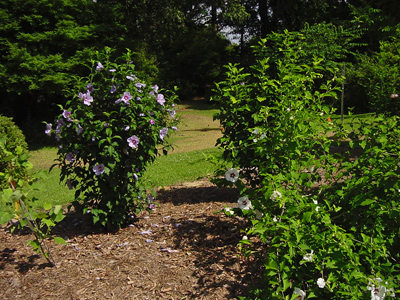
As we look at the selections, Stevie Wonder would choose
'Blue Angel' for the bloom display on the left side.
|
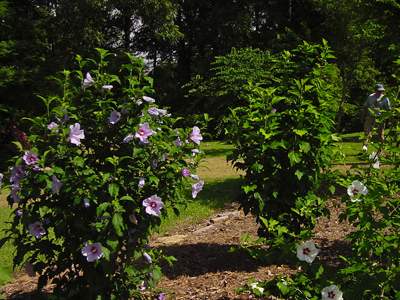
Here comes the plant finder (Greg) looking for the next
big Texas SuperStar.
|
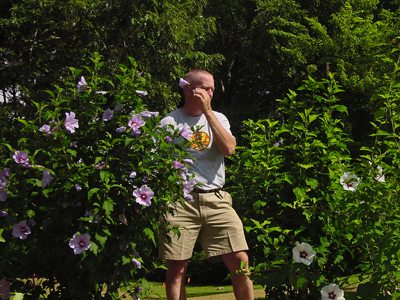
Greg has to get flowers from 'Blue Angel' for the image since
THERE ARE NONE on the 4-years-to-bloom althea.
|
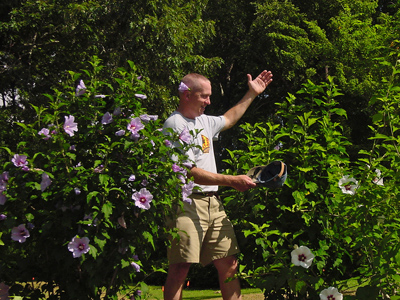
Greg chooses the 4-years-to-bloom Althea over
floriferous 'Blue Angel'!
|
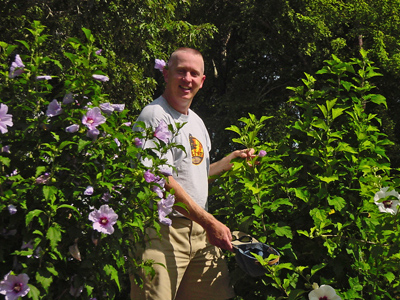
Greg with 4-years-to-bloom althea (on the right)
by 'Blue Angel' (full of bloom on the left)!!!
|
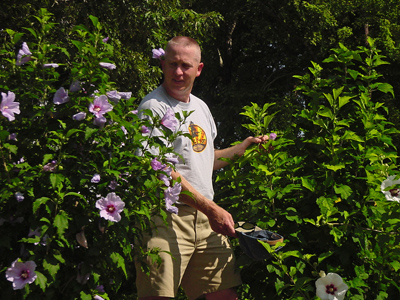
Hey!! 'Blue Angel' DOES have blooms
and 4-years-to-bloom has only one bud!!
|
Blue Angel TM Shrub Althea (May 2018 Promotion)
By Dr. Mike Arnold
Hibiscus syriacus ‘Greba’
Hibiscus syriacus ‘Greba’, marketed under the name Blue Angel TM Shrub Althea, is a delightful Hibiscus syriacus developed by Dr. Sam McFadden.
Exposure: Best flowering is in full sun or light afternoon shade. Shady locations tend to reduce flower production.
Height: This cultivar is somewhat smaller than the typical species type, maturing at 6 to 8 feet after several years. Plants eventually form upright oval to vase-shaped habits with a spread equal to or often less than their height.
Plant type: Erect woody deciduous shrub or small tree.
Planting time: Bare root plants in early winter, container-grown or balled-and-burlapped plants year-round.
Soil type: Well drained soils are needed. Plants are usually well adapted to a range of soil pH, but may occasionally require iron chelate on very high pH soils; plants are favorably responsive to good fertility, but can persist in low to moderate fertility soils. These shrubs are moderately drought tolerant once established.
Suggested uses: Blue Angel TM can be incorporated in the landscape as a general-purpose deciduous shrub, warm season accent, limbed up as a small tree, or grown in large landscape containers. Flowers provide ecosystem services as pollinator and hummingbird attractants and are sometimes employed as cut flowers for floral arrangements. These shrubs are useful in USDA hardiness zones 5 to 8 (9); insufficient winter chilling can sometimes reduce or delay budbreak in warmer parts of zone 9.
Special notes: Not to be confused with Hibiscus moscheutos ‘Blue Angel’ which is a herbaceous perennial, not a woody shrub; avoid soils with cotton root rot; light aphid infestations can often be controlled by a removal with a strong stream of water.
|



